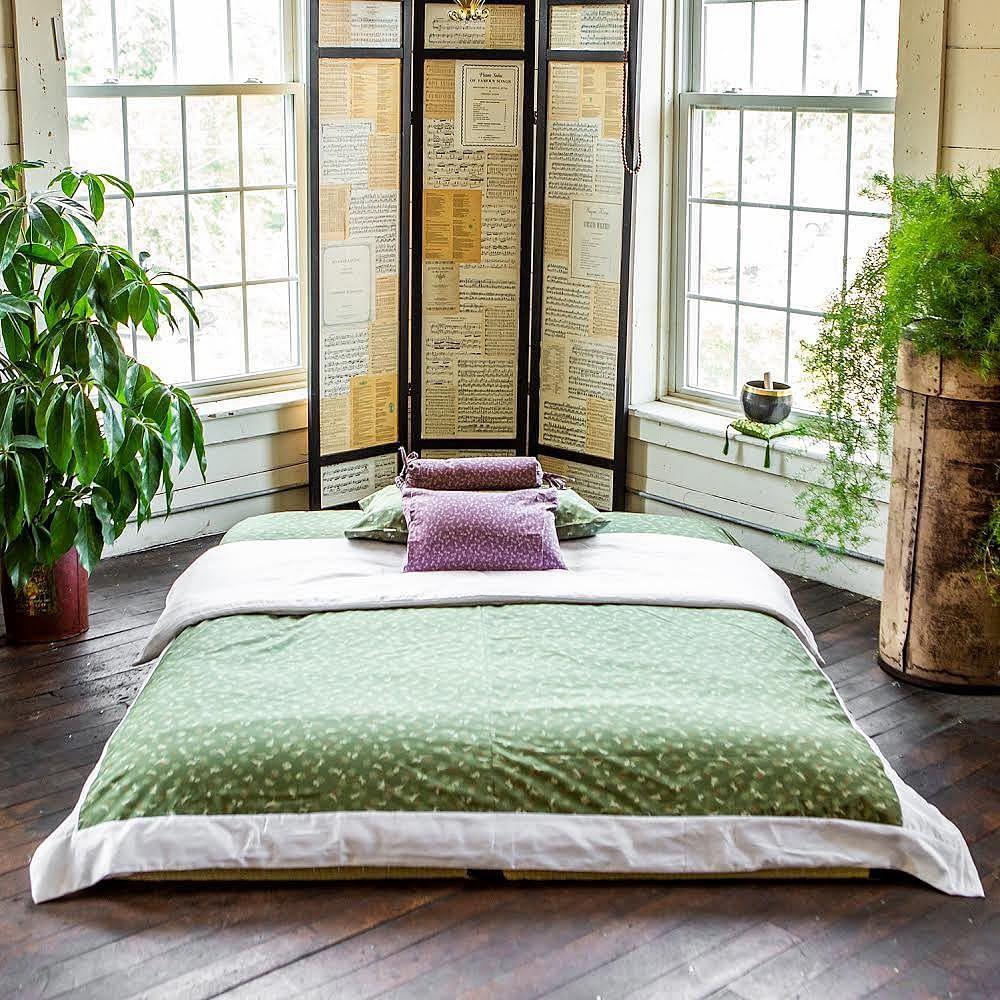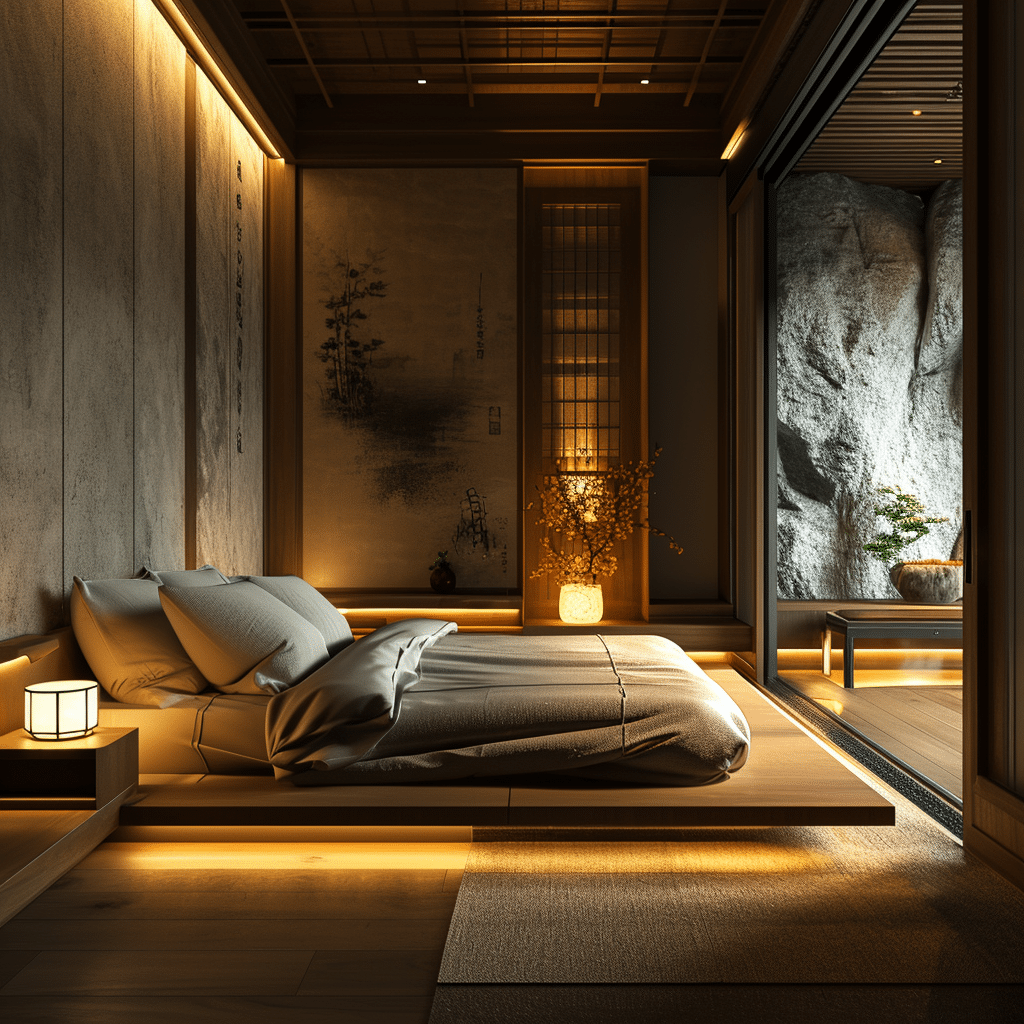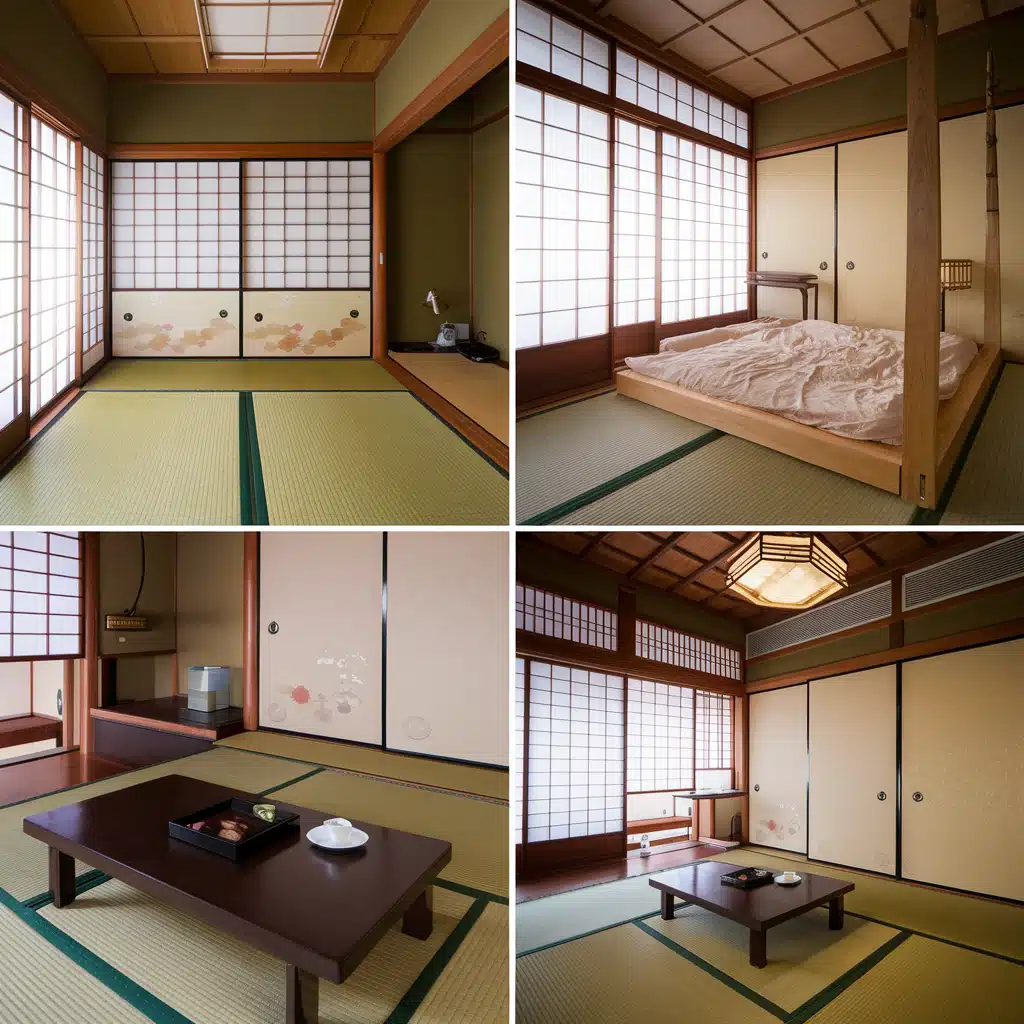The Guide to Furnish a Japanese Style Bedroom
Japanese-inspired design brings a sense of peace and simplicity to your personal space.
This guide will show you how to turn your bedroom into a restful haven, drawing on time-honored Japanese traditions.
By embracing these design principles, you’re not just changing your room but improving your well-being.
A Japanese-style bedroom can help reduce stress, improve sleep quality, and create an environment that nurtures body and mind.
Get ready to experience the transformative power of Japanese design in your own home.
What is a Traditional Japanese Bedroom?

Japanese bedrooms, known as “washitsu,” are built on principles of simplicity and harmony with nature.
Clean lines, natural materials, and a clutter-free environment characterize these spaces.
Low furniture, tatami mats, and sliding doors create a sense of openness in a traditional Japanese bedroom.
Step-by-Step Guide to Creating Your Japanese-Style Bedroom
Step 1: Declutter Your Space
Start by clearing out your room.
Remove anything you don’t need or use often.
Put away small items and keep surfaces clear.
This creates a calm feeling in your room.
In Japanese design, open space is important.
It helps the room feel peaceful and lets you focus on a few key items.
Step 2: Choose the Right Bed
For a true Japanese feel, use a futon on the floor.
You can roll it up during the day to save space.
If you prefer a regular bed, choose a low-platform bed.
This keeps the Japanese look while giving you a permanent sleeping spot.
Look for beds made of simple wood for the best effect.
Step 3: Select Natural Materials and Textures
Use natural materials like wood and bamboo in your room.
These materials are common in Japanese design.
Choose bedding made from cotton or silk.
Look for furniture with simple, clean lines.
Avoid shiny or artificial-looking materials.
Step 4: Implement Traditional Elements
Add tatami mats to your floor if possible.
If not, use a low-pile rug with a simple design.
Install shoji screens as room dividers or closet doors.
These paper screens let light through and add a classic Japanese touch.
You can also use shoji-style lamps for lighting.
Step 5: Apply a Calming Color Scheme
Choose neutral colors for your walls and large furniture pieces.
Beige, white, and soft grays work well in Japanese-style rooms.
Add pops of color with natural tones like moss green or cherry blossom pink.
Keep your bedding in neutral shades to maintain a calm atmosphere.
Use the same color scheme for your curtains to create a cohesive look.
Step 6: Optimize Lighting
Make the most of natural light during the day.
Use sheer curtains to let in sunlight while maintaining privacy.
For evening lighting, install dimmable lights or use paper lanterns.
Avoid harsh overhead lighting.
Instead, use soft, warm lighting to create a cozy atmosphere.
Step 7: Add Minimalist Decorations
Choose a few meaningful art pieces to display.
Look for simple designs or traditional Japanese artwork.
Add plants like bamboo or bonsai trees for a natural touch.
Use a small water feature for a calming sound.
Remember, in Japanese design, less is more.
Step 8: Maintain the Aesthetic
Keep your room tidy by putting things away after use.
Make your bed every morning to maintain a clean look.
Regularly dust and clean to keep the space fresh.
Avoid bringing unnecessary items into the room.
Take a few minutes each day to appreciate and enjoy your peaceful space.
Benefits of Japanese-style bedrooms
Adopting Japanese bedroom design can significantly improve your living experience:
- Enhanced relaxation: The minimalist approach reduces visual noise, promoting a sense of calm.
- Better sleep quality: Natural materials and soothing colors can improve sleep.
- Improved air quality: Natural materials like wood and paper help regulate humidity and airflow.
- Versatile space: Traditional Japanese rooms can easily serve multiple daily purposes.
- Connection to nature: Japanese design often incorporates elements that bring the outdoors inside, fostering a sense of peace.
By embracing these design principles, you’re creating more than just a beautiful room—crafting a space supporting your overall well-being.
Key Design Elements of Japanese-Inspired Bedroom

Japanese bedroom design is built on several fundamental elements that create a serene and harmonious space.
Let’s explore these key components in detail:
1. Minimalist Design
At the heart of Japanese bedroom design is the concept of minimalism. This approach focuses on:
- Decluttering: Remove unnecessary items to create a clean, open space.
- Simplicity: Choose furniture and decor with clean lines and simple shapes.
- Functionality: Every item should serve a purpose, avoiding purely decorative objects.
By embracing minimalism, you create a calm environment free from distractions, allowing your mind to relax and unwind.
2. Natural Materials
Japanese design places great importance on using natural materials to foster a connection with nature:
- Wood: Opt for light-colored woods like pine, cedar, or bamboo for furniture and flooring.
- Stone: Incorporate small stone elements for a grounding effect.
- Natural fabrics: Choose cotton, linen, or silk for bedding and curtains.
These materials bring warmth and texture to the space while promoting a sense of harmony with the natural world.
3. Neutral Color Palette
A Japanese-inspired bedroom typically features a soothing color scheme:
- Base colors: Soft whites, beiges, and light grays create a calming backdrop.
- Accent colors: Subtle earth tones like muted greens, blues, or browns add depth.
Avoid bright or bold colors that may disrupt the peaceful atmosphere.
This gentle color palette helps create a tranquil environment conducive to rest and relaxation.
4. Low-Profile Furniture
Traditional Japanese bedrooms feature low-lying furniture that keeps you close to the ground:
- Futon or low platform bed: These sleeping arrangements promote good posture and a connection to the earth.
- Low tables or nightstands: Choose pieces that complement the bed’s height.
- Floor cushions: Use these for seating or meditation instead of chairs.
Low-profile furniture enhances the sense of space and openness in the room.
5. Shoji Screens and Fusuma Doors
These traditional Japanese elements serve multiple purposes:
- Room dividers: Create flexible spaces within your bedroom.
- Light diffusion: Allow soft, natural light to filter through.
- Privacy: Provide a sense of seclusion without feeling closed in.
Shoji screens and Fusuma doors add authenticity and functionality to your Japanese-inspired bedroom.
6. Tatami Flooring
While not essential, tatami mats can greatly enhance the Japanese feel of your bedroom:
- Traditional material: Made from rice straw and rush grass.
- Comfort: Provides a soft, warm surface for walking and sitting.
- Aesthetic appeal: Adds texture and a natural element to the room.
If full tatami flooring isn’t possible, consider incorporating a small area for meditation or relaxation.
7. Zen-Inspired Elements
Bring the calming influence of Zen philosophy into your bedroom:
- Indoor plants: Add small potted plants or a bonsai tree.
- Rock garden: Create a miniature version on a tray for contemplation.
- Water features: A small fountain can provide soothing sounds.
These elements help create a meditative atmosphere that encourages mindfulness and inner peace.
By thoughtfully incorporating these key design elements, you can create a Japanese-inspired bedroom as a true sanctuary for rest and rejuvenation.
Remember, the goal is to create a space that feels balanced, harmonious, and deeply connected to nature.
Creating a Serene Japanese-Inspired Atmosphere
1. Lighting
Soft, diffused lighting is crucial for a calming Japanese bedroom:
- Natural light: Maximize daylight with sheer curtains or adjustable blinds.
- Paper lanterns: Use these for a gentle, warm evening glow.
- Dimmable lights: Install fixtures that allow you to adjust brightness as needed.
- Candles: Consider unscented candles for a meditative ambiance.
Remember, harsh overhead lighting can disrupt the peaceful mood, so opt for softer options that mimic natural light.
2. Sound
Create a peaceful auditory environment:
- White noise: A small fan or sound machine masks outside noises.
- Nature sounds: Play soft recordings of rain, forest sounds, or gentle streams.
- Wind chimes: Hang small, subtle chimes near a window for gentle tinkling.
- Silence: Embrace quiet moments as part of your bedroom’s tranquility.
The goal is to minimize jarring or disruptive sounds while introducing calming audio elements.
3. Scent
Engage the sense of smell to enhance relaxation:
- Essential oils: Use a diffuser with calming scents like lavender, jasmine, or hinoki (Japanese cypress).
- Incense: Burn subtle, natural incense for a traditional touch.
- Fresh air: Ensure good ventilation to keep the air clean and fresh.
- Natural materials: The scent of tatami mats or wooden elements can add to the calming atmosphere.
Avoid strong or artificial fragrances that might overwhelm the space.
4. Texture
Incorporate a variety of textures to create a rich sensory experience:
- Smooth woods: Choose furniture with a silky finish.
- Soft fabrics: Use high-quality cotton or silk for bedding and cushions.
- Rough natural elements: Introduce small stone features or rustic pottery.
- Tatami mats: If used, these provide a unique texture underfoot.
The mix of textures should be subtle and harmonious, not jarring or contrasting.
5. Space and Flow
The arrangement of your room affects its energy and atmosphere:
- Clear pathways: Ensure easy movement around the room.
- Balanced layout: Arrange furniture symmetrically for a sense of order.
- Open space: Leave empty areas to create a feeling of spaciousness.
- Nature views: If possible, position the bed to see outdoors.
A well-arranged space promotes a sense of calm and allows energy to flow smoothly.
6. Mindful Decor
Choose decor items thoughtfully to maintain a serene environment:
- Minimalist art: Opt for simple ink drawings or calligraphy.
- Natural objects: Display a single flower in a vase or a small bonsai tree.
- Meaningful items: Include only objects that bring you joy or peace.
- Avoid clutter: Resist the urge to fill every surface with decorative items.
Each piece should contribute to the overall sense of tranquility in the room.
Incorporating Traditional Japanese Furniture and Accessories

Japanese bedrooms are known for their minimalist yet functional furniture and carefully chosen accessories. Let’s explore how to incorporate these elements into your space:
1. Low Platform Bed
The centerpiece of a Japanese bedroom is typically a low bed:
- Height: Choose a bed frame that sits close to the ground, ideally 6-12 inches high.
- Material: Opt for natural wood like pine, oak, or cherry.
- Design: Look for simple, clean lines without ornate details.
- Headboard: A low, wooden headboard or none at all is common.
If a platform bed isn’t possible, you can recreate the look with a low-profile mattress directly on the floor.
2. Futon
For a truly authentic experience, consider using a traditional Japanese futon:
- Portability: Futons can be rolled up and stored during the day, freeing up space.
- Comfort: Choose a high-quality futon mattress for proper support.
- Bedding: Use simple, natural fiber sheets and a light comforter.
- Storage: Invest in a decorative chest or closet to store the futon when not in use.
Futons offer flexibility and maintain the low-profile aesthetic of Japanese bedrooms.
3. Low Tables and Floor Cushions
Replace standard nightstands and seating with low alternatives:
- Chabudai: These low, wooden tables serve multiple purposes.
- Zabuton: Large, flat cushions for comfortable floor seating.
- Materials: Choose items made from natural fibers and woods.
- Functionality: Ensure these pieces serve a clear purpose to avoid clutter.
These low-profile furnishings maintain the room’s open feel and encourage a grounded lifestyle.
4. Storage Solutions
Keep the space organized with traditional Japanese storage options:
- Tansu: Traditional Japanese chests with multiple drawers.
- Built-in closets: If possible, incorporate sliding door closets for hidden storage.
- Bamboo baskets: Use these for storing small items or laundry.
- Under-bed storage: If using a platform bed, utilize the space underneath.
The key is to have ample storage that keeps belongings out of sight, maintaining the room’s serene atmosphere.
5. Shoji Screens and Fusuma Doors
These traditional elements serve both functional and aesthetic purposes:
- Room dividers: Use to create separate areas within the bedroom.
- Window coverings: Replace heavy curtains with shoji screens for a softer light.
- Closet doors: Install sliding fusuma doors for a seamless look.
- Materials: Choose sustainably sourced wood and high-quality paper or fabric.
These screens and doors add authenticity while providing flexible space management.
6. Lighting Fixtures
Select lighting that complements the Japanese aesthetic:
- Andon lamps: Traditional lantern-style lamps for a soft, warm glow.
- Bamboo pendants: Overhead lighting with natural materials.
- Floor lamps: Choose simple designs with paper or fabric shades.
- Candle holders: Incorporate traditional Japanese designs for ambient lighting.
Focus on soft, diffused lighting that creates a calm atmosphere.
7. Decorative Accents
Add subtle decorative elements to enhance the room’s character:
- Ikebana: Japanese flower arranging in simple vases.
- Calligraphy scrolls: Hang a single scroll with a meaningful character or phrase.
- Bonsai: Small, carefully pruned trees bring nature indoors.
- Natural art: Consider woodblock prints or ink-wash paintings.
Remember, in Japanese design, less is more. Choose a few meaningful pieces rather than cluttering the space.
By thoughtfully selecting and arranging these traditional furniture pieces and accessories, you can create a bedroom that authentically reflects Japanese design principles.
The result will be a space that looks beautiful, functions well, and promotes a sense of peace and harmony.
Embracing Natural Elements and Zen Philosophy

Japanese design is deeply rooted in a connection with nature and the principles of Zen philosophy.
1. Bringing Nature Indoors
Incorporate natural elements to create a strong connection with the outdoors:
- Indoor plants: Choose low-maintenance options like bamboo, bonsai, or small ferns.
- Natural light: Maximize window space and use sheer curtains to let in sunlight.
- Wood accents: Use untreated or lightly finished wood for furniture and decor.
- Stone elements: Incorporate small pebbles or a rock garden for a grounding effect.
The goal is to blur the lines between indoor and outdoor spaces, creating a sense of harmony with nature.
2. Creating a Meditation Space
Designate an area for mindfulness and reflection:
- Zabuton cushions: Provide comfortable seating for meditation.
- Low table: Use as a surface for candles, incense, or meaningful objects.
- Minimalist decor: Keep the area simple to avoid distractions.
- Privacy screens: Use shoji screens to create a secluded nook if space allows.
This area serves as a personal retreat within your bedroom, promoting daily mindfulness practices.
3. Incorporating Water Elements
Water features can add a soothing presence to your space:
- Small fountain: Choose a simple tabletop design for gentle background noise.
- Fish bowl: A single fish in a clean, minimalist bowl can be calming.
- Water imagery: If actual water isn’t practical, consider art depicting serene water scenes.
The sound and sight of water can have a calming effect, enhancing the room’s peaceful atmosphere.
4. Cultivating Simplicity
Embrace the Zen concept of simplicity in your design choices:
- Clutter-free surfaces: Keep tabletops and shelves mostly bare.
- Quality over quantity: Choose fewer, high-quality items rather than many decorative pieces.
- Hidden storage: Use closets and drawers to keep non-essential items out of sight.
- Minimalist art: Select one or two pieces that bring you joy and peace.
Remember, in Zen philosophy, empty space is as important as the objects within it.
5. Balancing Elements
Create harmony through thoughtful arrangement:
- Symmetry: Arrange furniture and decor items in balanced pairs.
- Odd numbers: When grouping objects, use groups of three or five for visual interest.
- Scale: Ensure furniture and accessories are proportionate to the room size.
- Flow: Arrange items to create a natural, unobstructed path through the room.
The goal is to create a sense of equilibrium that feels natural and calming.
6. Incorporating Mindful Rituals
Design your space to support daily mindfulness practices:
- Tea ceremony area: Set up a small chabudai table for mindful tea drinking.
- Incense holder: Choose a simple, beautiful holder for occasional use.
- Journal space: Designate a spot for daily reflection and writing.
- Yoga mat storage: If you practice yoga, create a dedicated space for your mat.
These elements encourage regular mindfulness practices, enhancing the room’s role as a sanctuary.
By incorporating these natural elements and Zen principles, you create more than just a beautiful space – you craft an environment that nurtures your spirit and promotes inner peace.
This approach transforms your bedroom into a true sanctuary, supporting both physical rest and mental rejuvenation.
Color Palette and Textiles in Japanese Bedroom Design

The color scheme and choice of textiles play a vital role in achieving the serene atmosphere characteristic of Japanese bedrooms.
Let’s explore how to select and incorporate these elements effectively.
1. Traditional Color Palette
Japanese design typically favors a subtle, nature-inspired color scheme:
- Neutrals: Soft whites, beiges, and light grays form the base of the color palette.
- Earth tones: Gentle browns, warm tans, and muted greens add depth and warmth.
- Accents: Soft blues reminiscent of sky and water or pale sakura (cherry blossom) pink for a touch of color.
Avoid using bright or bold colors that might disrupt the calm atmosphere. The goal is to create a soothing, harmonious environment.
2. Applying the Color Scheme
Implement your chosen palette thoughtfully throughout the room:
- Walls: Paint in neutral tones or use natural wood paneling.
- Flooring: Opt for light wood or tatami mats in their natural color.
- Furniture: Choose pieces in natural wood tones or neutral colors.
- Bedding: Select linens in soft, muted shades.
- Accents: Use small decor items or art pieces to introduce subtle pops of color.
Remember, the overall effect should be calming and cohesive, without any single element standing out too boldly.
3. Natural Fiber Textiles
Japanese design emphasizes the use of natural materials, including textiles:
- Cotton: Lightweight and breathable, ideal for bedding and curtains.
- Linen: Adds texture and casual elegance to the space.
- Silk: Use sparingly for a touch of luxury in cushions or throws.
- Wool: Consider a small wool rug for warmth and texture.
These materials look and feel good and connect the space to nature.
4. Bedding Choices
Select bedding that aligns with Japanese aesthetic principles:
- Simplicity: Choose solid colors or very subtle patterns.
- Layers: Use thin layers rather than thick, heavy bedding.
- Futon: If using a traditional futon, select one with a cotton or wool filling.
- Pillows: Opt for a mix of firm and soft pillows in coordinating neutral tones.
The bed should look inviting yet uncluttered, promoting a sense of calm.
5. Window Treatments
Choose window coverings that filter light softly:
- Shoji screens: Traditional paper screens that diffuse light beautifully.
- Bamboo blinds: Offer privacy while maintaining a natural aesthetic.
- Light curtains: If using curtains, select those made from natural fibers in neutral tones.
The goal is to allow natural light while maintaining privacy and the room’s serene atmosphere.
6. Decorative Textiles
Use textiles sparingly as decorative elements:
- Zabuton cushions: Floor cushions in coordinating colors for seating.
- Noren curtains: Hanging fabric dividers with simple designs or solid colors.
- Wall hangings: Consider a single textile art piece, like a traditional furoshiki cloth.
These elements add texture and interest without cluttering the space.
7. Seasonal Considerations
In traditional Japanese homes, textiles are often changed with the seasons:
- Summer: Lighter fabrics and cooler colors create a sense of refreshment.
- Winter: Warmer tones and slightly heavier textiles for coziness.
- Spring/Fall: Incorporate subtle nods to seasonal changes, like cherry blossom motifs in spring.
This practice connects your space to the year’s natural rhythms, enhancing the overall sense of harmony with nature.
You create a visually cohesive and tactilely pleasing environment by carefully selecting and implementing these color and textile choices.
The result is a bedroom that looks authentically Japanese and feels deeply calming and in tune with nature’s rhythms.
This thoughtful approach to color and textiles helps transform your bedroom into a haven of tranquility and rest.
Lighting and Ambiance in Japanese Bedroom Design
Lighting plays a crucial role in Japanese interior design, contributing significantly to the room’s atmosphere and functionality. Let’s explore how to create the right lighting scheme for your Japanese-inspired bedroom.
1. Natural Light
Maximizing natural light is a key principle in Japanese design:
- Window placement: If possible, position the bed to face east, allowing morning light to gently wake you.
- Sheer curtains: Use light, translucent fabrics to filter sunlight without blocking it completely.
- Reflective surfaces: Incorporate light-colored walls and floors to bounce natural light around the room.
Natural light helps maintain a connection with the outside world and supports your body’s natural rhythms.
2. Soft Artificial Lighting
When natural light isn’t sufficient, use artificial lighting that mimics its soft quality:
- Ambient lighting: Install dimmable overhead lights or wall sconces that provide a gentle, even glow.
- Task lighting: Use adjustable reading lamps near the bed or desk areas.
- Accent lighting: Highlight art pieces or plants with small, focused lights.
Aim for a layered lighting approach that allows you to adjust the room’s brightness as needed.
3. Traditional Japanese Lighting Fixtures
Incorporate authentic Japanese lighting elements for added character:
- Andon lamps: These traditional paper lanterns provide a warm, diffused light.
- Shoji lamps: Table or floor lamps with wooden frames and paper shades.
- Bamboo pendants: Overhead lights made from natural bamboo create interesting shadows.
These fixtures add to the room’s authentic feel while providing functional lighting.
4. Candles and Lanterns
For a meditative atmosphere, consider including:
- Candle holders: Choose simple, elegant designs in natural materials.
- Stone lanterns: Small versions of traditional garden lanterns can serve as decorative lighting.
- Tea lights: Use in small dishes or holders for a subtle, flickering glow.
Use these sparingly and always with safety in mind, especially if you have shoji screens or other paper elements in the room.
5. Creating Zones with Light
Use lighting to define different areas within the bedroom:
- Brighter light: Near dressing areas or desks for task-oriented activities.
- Softer light: Around the bed and seating areas for relaxation.
- Adjustable options: Install dimmer switches or smart bulbs to easily change the room’s mood.
This zoning helps the room serve multiple purposes while maintaining an overall sense of calm.
Maintenance and Care for Your Japanese-Style Bedroom

Creating a Japanese-inspired bedroom is just the beginning.
Proper maintenance and care are essential to preserve its serene atmosphere and ensure the longevity of its elements.
Here’s how to keep your space in pristine condition:
1. Tatami Mat Care
If you’ve incorporated tatami mats, they require special attention:
- Regular cleaning: Vacuum gently or use a soft broom weekly.
- Stain removal: Clean spills immediately with a damp cloth, avoiding excess moisture.
- Rotation: Turn mats periodically to ensure even wear.
- Sunlight exposure: Allow occasional sunlight to naturally disinfect the mats.
- Professional cleaning: Schedule deep cleaning annually.
Proper care will extend the life of your tatami mats and maintain their natural beauty.
2. Wood Maintenance
Many Japanese-style bedrooms feature wooden elements:
- Dusting: Use a soft, dry cloth regularly to prevent dust buildup.
- Cleaning: Wipe with a slightly damp cloth for deeper cleaning, avoiding harsh chemicals.
- Polishing: Apply natural beeswax or oil periodically to maintain the wood’s luster.
- Humidity control: Use a dehumidifier if needed to prevent warping or cracking.
Regular care keeps wooden furniture and fixtures looking their best.
3. Shoji Screen and Fusuma Door Upkeep
These delicate elements require gentle handling:
- Cleaning: Dust with a soft, dry cloth or use a vacuum with a brush attachment.
- Paper repair: Replace torn paper promptly to maintain appearance and function.
- Track maintenance: Keep sliding tracks clean and lubricated for smooth operation.
- Frame care: Wipe wooden frames with a slightly damp cloth and dry immediately.
Proper care ensures these traditional elements remain functional and beautiful.
4. Textile Care
Natural fiber textiles common in Japanese design need appropriate care:
- Bedding: Wash according to care labels, typically in cool water with mild detergent.
- Zabuton cushions: Spot clean when necessary and air out regularly.
- Curtains: Gentle machine washing or professional cleaning as needed.
- Seasonal rotation: Store off-season textiles clean and dry to prevent mold.
Regular care keeps textiles fresh and extends their lifespan.
5. Air Quality Maintenance
Maintain a clean, fresh atmosphere:
- Ventilation: Open windows regularly for air circulation.
- Air purification: Consider using bamboo charcoal or small plants to purify air naturally.
- Incense use: If using incense, do so sparingly to avoid residue buildup.
- Humidifier: Use in dry seasons to maintain optimal humidity levels.
Good air quality contributes to the overall health of your space and its occupants.
6. Mindful Cleaning Routine
Adopt a cleaning approach that aligns with Japanese principles:
- Daily tidying: Spend a few minutes each day returning items to their designated places.
- Weekly cleaning: Perform a thorough clean, including dusting and vacuuming.
- Seasonal deep clean: Conduct a more intensive cleaning and organization session quarterly.
- Natural cleaning products: Use gentle, eco-friendly cleaners to maintain harmony with nature.
Regular maintenance prevents the need for more intensive cleaning sessions.
7. Feng Shui Maintenance
Periodically reassess your room’s energy flow:
- Space clearing: Use bells or clapping to clear stagnant energy.
- Furniture placement: Adjust positions if the room’s flow feels off.
- Decluttering: Regularly remove items that no longer serve a purpose or bring joy.
- Energy renewal: Refresh plants or flowers to maintain vibrant chi.
These practices help maintain the room’s harmonious energy.
8. Seasonal Adjustments
Embrace the Japanese tradition of adapting your space to the seasons:
- Bedding changes: Switch to lighter fabrics in summer and warmer in winter.
- Decor updates: Rotate art or small decor items to reflect the current season.
- Lighting adjustments: Modify light intensity and warmth with changing daylight hours.
- Nature elements: Bring seasonal plants or flowers to connect with the outside world.
These changes keep your bedroom in harmony with nature’s rhythms.
Final Thoughts
So, to create a Japanese-inspired bedroom goes beyond mere aesthetics.
It’s about crafting a peaceful haven that nurtures your well-being.
By incorporating elements like low-profile furniture, natural materials, and a calm color scheme, you’ve set the stage for peace.
Remember, the essence lies in simplicity and connection to nature. Your bedroom should feel like a retreat from the world’s complexities.
The care routines we’ve discussed are more than maintenance – rituals that deepen your bond with your space.
As you settle into your new environment, its influence might spread to other parts of your life.
The focus on mindfulness and finding beauty in simplicity can shape your daily experiences.







